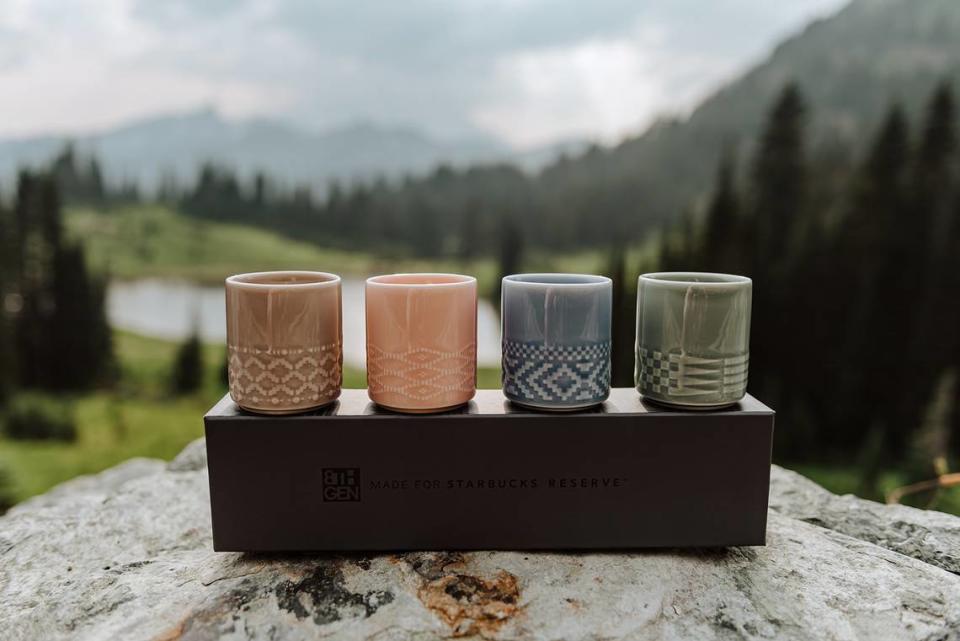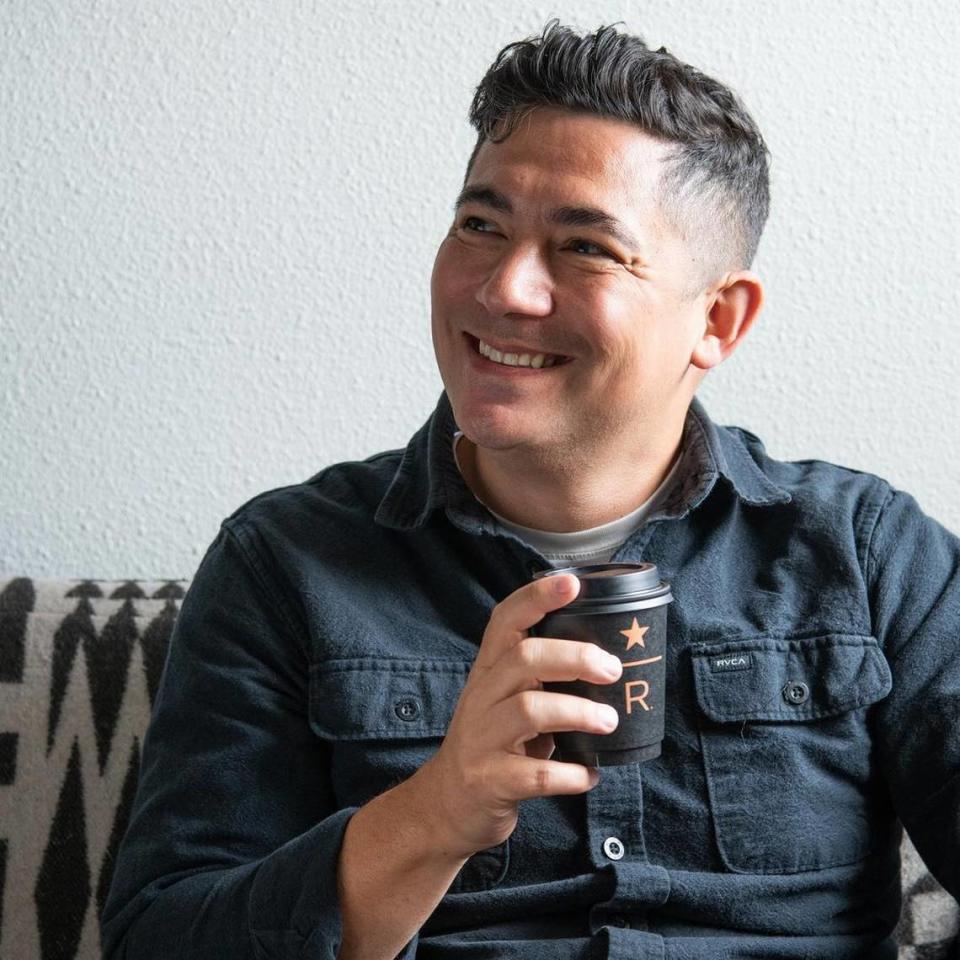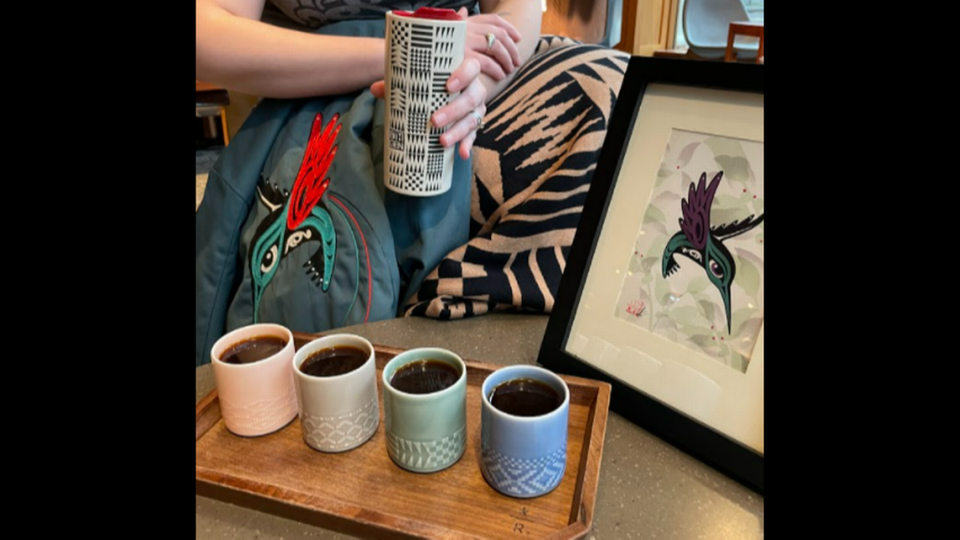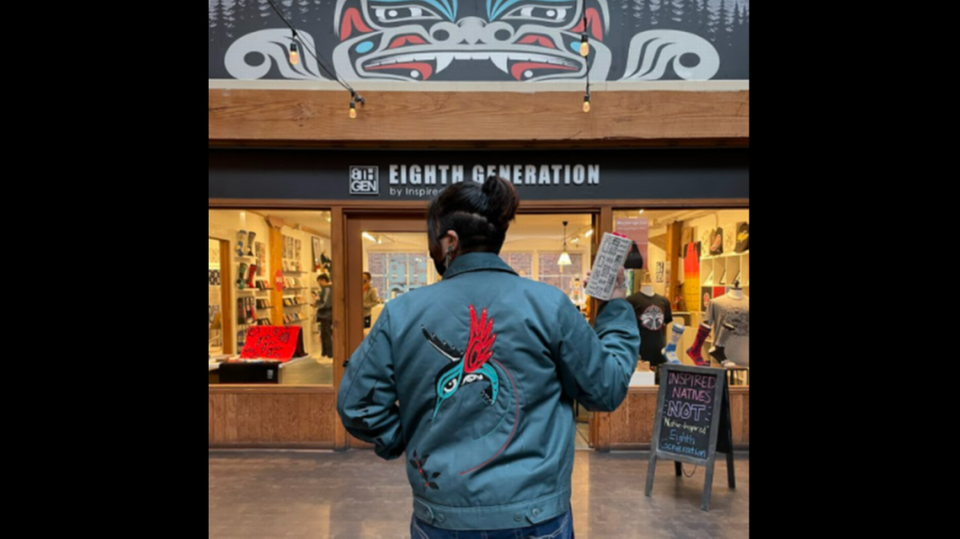Eighth Generation founder weaves heritage and healing to reclaim space for Native art
- Oops!Something went wrong.Please try again later.
This profile is one of a series on the contributions, cultural knowledge and strength of Native peoples in celebration of November’s Native American Heritage Month.
Nooksack artist, activist and educator Louie Gong is known as the founder of Eighth Generation — a Seattle-based art and lifestyle brand now owned by the Snoqualmie Tribe.
Using traditional Coast Salish art, he merges his urban environment and mixed heritage to create impactful pieces that make strong statements about identity and Native representation.
From launching the first Native-owned retail store in Pike Place Market to becoming the first Native-owned company to produce wool blankets, Gong’s vision has led Eighth Generation as not only an incredible force in local business, but also in the global economy.
Collaborating with companies like Starbucks, Eighth Generation’s new “decolonization partnership” is breaking norms in how big brands work with small businesses. And with a focus in uplifting the community, Eighth Generation’s employee base is 75% Native American, with many employees who started out in the store or warehouse.
The company also works with a diverse range of Indigenous artists with various Tribal affiliations. Each has contracts like Gong, who continues to license his work to the company, that are both generous and allows them to retain ownership of their work.
Additionally, as a well-known Native art company in the area, Gong and Eighth Generation are often asked by companies, galleries and cities to connect them with Native artists.
The unique model of Eighth Generation comes from Gong’s recognition that such spaces and opportunities didn’t exist for Native artists. In 2008, he began the for-profit company with a service-based mission to carve out the space needed to bring Indigenous artists onto a global stage.
Epitomized by the Inspired Natives™ Project — anchored by the tagline “Inspired Natives™, not Native-inspired” — Eighth Generation helps Indigenous artists build their business capacity and industry knowledge while addressing the economic impact of cultural appropriation.

The road to Eighth Generation
Before becoming the successful artist and CEO of the barrier-breaking company, Louie Gong was born and lived in Canada for the first 10 years of his life. Raised on an Indian reserve in a house without running water, he was raised by his paternal Chinese grandfather and Native grandmother.
“When I was about 11, we moved about 8 miles across the political border between the United States and Canada to the other side of Nooksack territory,” he said.
Having a Chinese name, being from a Native community and also being white, through his mother’s side, Gong’s existence often challenged peoples’ thoughts about identity and race. Living in a rural farming area and attending school in the Nooksack Valley School District in Whatcom County presented many difficulties for him.
In his work as president of MAVIN, a national non-profit that raises awareness about mixed race people and families, Gong’s commentary on race and cultural identity was featured in international media.
He’s known for a quote he told NBC Nightly News in 2010, “If we can remember 20 different ways to order our coffee, we can remember more than just six terms for describing our identity.”
Gong continues to serve on the advisory board of MAVIN and Mixed in Canada.
“Having a complex racial and cultural identity set the stage for the style that I use to maneuver in my life,” Gong said. “My effort to reconcile how I was perceived and who I knew I was was the defining challenge of my youth.”
“I spent a lot of time pursuing social acceptance. I didn’t have the energy reservoirs to focus on excelling in school.”
From the ages of 14 to 23, Gong primarily lived by himself in the Nooksack community.
“In retrospect, I realized being left to my own wit and resilience taught me a lot of lessons that have been valuable in my entrepreneurial journey, but at that time I was really focused on meeting my own basic needs rather than excelling in school.”
Gong found freedom in choosing his own pace and schedule while attending college. He thrived at Whatcom Community College and later transferred to Western Washington University.
Reflecting on the experiences of his mother, who was schizophrenic and institutionalized during his childhood, Gong decided to pursue a bachelor’s degree in psychology, completing it in 1996.
“For me, I never knew what was wrong with my mom and no one in my family had the tools to talk to me about it,” he said. “So the mystery around my mom’s mental illness was probably a big factor in why I chose to go into mental health counseling.”
“It was like structuring my own healing. Being in counseling school for six years is like being in therapy for six years. Once you have names for things, they have a whole lot less power over you.”

Imagining in Coast Salish designs
Beginning in 1993, he worked with Native kids in the Nooksack Valley and Mount Baker School districts and earned a master’s degree in education. He also spent his career as a school counselor and mental health therapist working on behalf of low income and first generation students in Nooksack, other school districts, abroad in Korea, the University of Washington’s Educational Opportunity Center first and Muckleshoot Tribal College.
At Muckleshoot Tribal College as the GED and educational resources coordinator, Gong attended the canoe journey in 2007. There, he helped the language program make drums for giveaway.
After painting Coast Salish designs onto a few drums, Tribal members sought him out throughout the journey to paint theirs.
“I began imagining things in Coast Salish designs. I’d sit in traffic and look at the car in front of me and think about how I could bring that to life with the Coast Salish style,” he said. “So even elders asking me to paint their drums really enforced the idea in me that I can do this.”
While at work one day, he saw someone wearing Vans shoes and remembered as a child, he had always wanted Vans, but couldn’t afford them. So he went to the store to grab a pair.
“I looked up on the shelf and saw a lot, but they didn’t connect with me. So I took a plain pair home, grabbed a Sharpie and went to work,” he said.
After gaining notoriety for his shoes — having over 50,000 followers on Facebook, which was practically unheard of in 2008 — Gong used the momentum to launch workshops around identity. Using his professional background and experience as an Indigenous person, he developed a workshop methodology aligned with national learning standards.
The popularity of his workshops allowed him to use the proceeds to begin Eighth Generation’s endeavor into wool blankets without additional outside capital while aiming to make Native art accessible and still pay Native artists fair wages.

The Eighth Gen model
“For us, price range is important. It’s not just the art work that’s valuable,” Gong said. “Some projects are going to be less accessible. But there’s so much cool stuff at Eighth Generation for any budget and the likelihood that you’re gifted a blanket or get access through our many donations to service organizations is extremely high.”
As the company continues to grow, every aspect is practically new.
“There’s no precedent for a business like this,” he said. “Wool blankets are a pinnacle project in terms of having Indigenous art on it. I could’ve focused on playing cards and mugs, but I felt the best platform to make the statement I wanted to make was wool blankets.”
Now growing at an astronomical rate and using cutting edge technology to make numerous products — including many in-house at its new warehouse in Seattle — Eighth Generation continues to challenge cultural appropriation of Native art. Following the acquisition of the company by the Snoqualmie Tribe in 2019, the company has continued to thrive.
“Wool blankets was a completely untapped business landscape for a Native company. How do we do things differently? Tell our own story?” Gong said. “In 2015, consumers had access to more information than ever before so if we came to the market with a good, organic story in front of consumers who are interested in doing the right thing, they would choose Eighth Generation over a company like Pendleton.”

Art as healing
Today, Gong pursues art in many different ways. He typically starts with a sketch, vectorizes it, does mock ups and adjustments before executing it as a painting.
“I do two or three versions. 60% is planned before putting it on a wood panel, 40% in the moment,” he said.
His latest piece, “FOO, the Black Sheep” is a deep-dive into the trauma many experienced during the pandemic.
“Your traumas and experiences aren’t ‘baggage.’ You can’t set them down and walk away. They’ll always be with you,” Gong said. “Art is one of the main ways I focus on healing.
“This piece is for everyone who experienced hurt from the pandemic. Whether it was the loneliness that gave them time to reflect on the hurt in their life or losing a loved one, it’s for them.”
Though he hopes to get back to his love of custom shoes and joked that soon, after 15 years, a custom shoe collaboration is coming, he said all his art is based in healing.
“I would not be healthy enough to make these pursuits without counseling school,” Gong said. “I had to focus on being a better person my entire life. The hard skills that I learned as a therapist and my subsequent professional experience helped me hit the ground running as an artist.”
Race and identity continue to play a big role in his work and his entrepreneurial efforts. Much of his work mixes his cultural background, like his piece “Guardians,” depicting two Chinese guardians lions — or Fu dogs — in Coast Salish design.
“As I got access to information through education, I realized that I was bumping up against invisible barriers that lie in front of all people of color, including mixed people,” Gong said. “And those are internalized expectations based on race. I knew when I was not having success it was because of those invisible barriers and not my own deficits.
“So the knowledge about how race-based expectations act as invisible barriers in our life inoculated me against internalizing the racism I was experiencing in my life.”
He said that before his success with Eighth Generation, his goal was just to solve the problems in front of him.
“Despite all the cultural appropriation of Native art here, I know that the success of Eighth Generation would not have happened without an art-friendly city like Seattle,” Gong said. “But that trauma and those skills have since evolved as I’m navigating this space as a Native artist. It’s allowed me to solve even more problems and help other Native artists — making this a successful space for all of us.”

